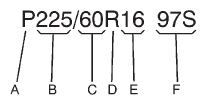Tire Size
The following is an example of a typical passenger vehicle tire size.

(A) Passenger (P&-Metric) Tire: The United States version of a metric tire sizing system. The letter P as the first character in the tire size means a passenger vehicle tire engineered to standards set by the U.S. Tire and Rim Association.
(B) Tire Width: The three&-digit number indicates the tire section width in millimeters from sidewall to sidewall.
(C) Aspect Ratio: A two&-digit number that indicates the tire height&-to&-width measurements. For example, if the tire size aspect ratio is 60, as shown in item C of the illustration, it would mean that the tire's sidewall is 60 percent as high as it is wide.
(D) Construction Code: A letter code is used to indicate the type of ply construction in the tire. The letter R means radial ply construction; the letter D means diagonal or bias ply construction; and the letter B means belted&-bias ply construction.
(E) Rim Diameter: Diameter of the wheel in inches.
(F) Service Description: These characters represent the load index and speed rating of the tire. The load index represents the load carrying capacity a tire is certified to carry. The speed rating is the maximum speed a tire is certified to carry a load.
See also:
Vehicle and Power Issues
OnStar services require a vehicle electrical system, wireless service, and GPS satellite technologies to be available and operating for features to function properly. These systems may not operate if ...
Replacing Airbag System Parts after a Crash
WARNING
A crash can damage the airbag systems in the vehicle. A damaged airbag system
may not work properly and may not protect you and your passenger(s) in a crash,
resulting in serious injury o ...
Instrument Panel Fuse Block
The instrument panel fuse block is located under the instrument panel on the passenger side of the vehicle. Pull down on the cover to access the fuse block.
Fuse Side
The vehicle may not be equipp ...





